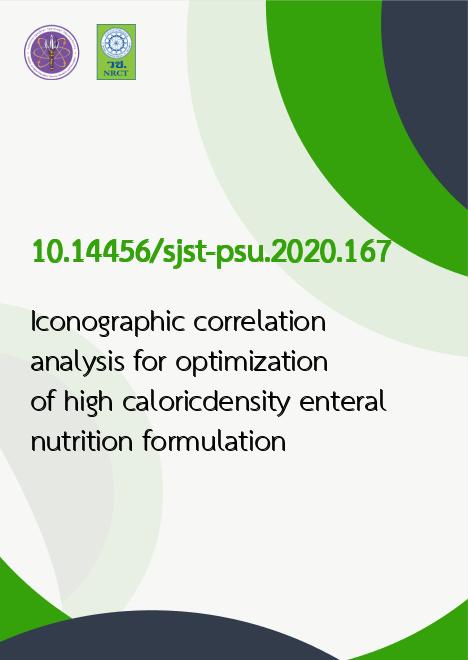
|
Iconographic correlation analysis for optimization of high caloricdensity enteral nutrition formulation |
|---|---|
| รหัสดีโอไอ | |
| Creator | 1. Tanathep Leungtongkum 2. Jirarat Anuntagool 3. C?line Leridon 4. Mohamad Hamoud-Agha 5. Jean-Claude Laguerre |
| Title | Iconographic correlation analysis for optimization of high caloricdensity enteral nutrition formulation |
| Publisher | Research and Development Office, Prince of Songkla University |
| Publication Year | 2563 |
| Journal Title | Songklanakarin Journal of Science and Technology |
| Journal Vol. | 42 |
| Journal No. | 6 |
| Page no. | 1286-1293 |
| Keyword | iconographic correlation, response surface methodology, optimization, enteral nutrition |
| URL Website | https://rdo.psu.ac.th/sjstweb/index.php |
| ISSN | 0125-3395 |
| Abstract | High caloric density enteral nutrition contains high amounts of carbohydrates, proteins and fats. Therefore, it is likelyto have either too high viscosity or unstable emulsion if not optimally formulated. Response surface methodology (RSM) is a toolfor optimization. To obtain the optimal formula, numerous formulas are needed to be prepared and determined if classical RSMusing a central composite design (CCD) is used since there are many involving factors. For this reason, the IconographicCorrelation (IC) could be compromising. In this study, 9 influencing factors were optimized. The desired response was thecomplex viscosity and a degree of emulsion separation. By using the IC, the number of experiments was reduced from 524treatments if the CCD was used to 17 treatments. The model describing significant logical interactions between factors towardeach response was proposed with excellent correlation, R2adj = 0.99, and 0.93 for complex viscosity, and emulsion separation,respectively. |
